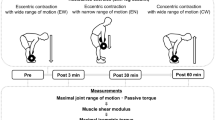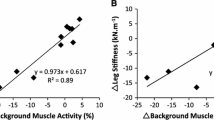Abstract
The aim of this study was to investigate the validity and reliability of an in vivo test of lower body musculotendinous stiffness. Male subjects (n = 23) with at least 12 months of weight training experience performed a series of quasi-static muscular actions in a supine leg press position during which a brief perturbation was applied. The resulting damped oscillations enabled each subject's maximal musculotendinous stiffness for the lower body musculature to be estimated. To assess the individual's capacity to benefit from active stretch, subjects also performed both a static jump and a countermovement jump. Statistical analysis revealed no significant different between day 1 and day 2 stiffness values (P < 0.01), an interday reliability ofr = 0.94 and a coefficient of variance of 8%. It was further demonstrated that maximal stiffness was significantly correlated to both isometric and concentric rate of force development (r = 0.50 andr = 0.54, respectively), and inversely related to the percentage difference between vertical jumps with and without prior stretch (r = − 0.54). Such results tend to suggest that the test is valid and are discussed with reference to the restitution of elastic strain energy, muscle potentiation and the interaction effects of elastic recoil on dynamic function. It was concluded that the assessment of stiffness of the lower body using the oscillation technique is a valid and reliable in vivo measure of musculotendinous stiffness.
Similar content being viewed by others
References
Alexander RM, Bennet-Clarke HC (1977) Storage of elastic strain energy in muscles and other tissues. Nature 265:114–117
Anderson FC, Pandy MG (1993) Storage and utilisation of elastic strain energy during jumping. J Biomech 26:1413–1427
Aruin AS, Prilutskii BI, Raitsin LM, Savel'ev IA (1979) Biomechanical properties of muscles and efficiency of movement. Hum Physiol 5:426–434
Asmussen E, Bonde-Peterson F (1974) Storage of elastic energy in skeletal muscles in man. Acta Physiol Scand 91:385–392
Baratta R, Solomonow M (1991) The effect of tendon viscoelastic stiffness on the dynamic performance of isometric muscle. J Biomech 24:109–116
Belli A, Bosco C (1992) Influence of stretch-shortening cycle on mechanical behaviour of triceps surae during hopping. Acta Physiol Scand 144:401–408
Bemben MG, Clasey JL, Massey BH (1990) The effect of the rate of muscle contraction on the force time parameters of male and female subjects. Res Q Exerc Sport 61:96–99
Blanpied P, Schmidt GL (1993) The difference in stiffness of the active plantarflexors between young and elderly human females. J Gerontol 48:M58-M63
Bosco C, Viitasalo JT, Komi PV, Luhtanen P (1982) Combined effect of elastic energy and myoelectrical potentiation during stretch-shortening exercise. Acta Physiol Scand 114:557–565
Bosco C, Luhtanen P, Komi PV (1983) A simple method for measurement of mechanical power in jumping. Eur J Appl Physiol 50:273–282
Cavagna GA (1970) Elastic bounce of the body. J Appl Physiol 29:275–289
Cavagna GA (1977) Storage and utilisation of elastic energy in skeletal muscle. Exerc Sports Sci Rev 5:89–129
Ettema GJC, Huijing PA (1989) Properties of the tendinous structures and series elastic component of EDL muscle-tendon complex of the rat. J Biomech 22:1205–1209
Ettema GJC, Huijing PA (1994) Skeletal muscle stiffness in static and dynamic contractions. J Biomech 27:1361–1368
Ettema GJC, Van Soest AJ, Huijing PA (1990) The role of series elastic structures in prestretched-induced work enhancement during isotonic and isokinetic contractions. J Exp Biol 154:121–136
Ettema GJC, Huijing PA, DeHaan A (1992) The potentiating effect of prestretch on the contractile performance of rat gastrocnemius medialis muscle during subsequent shortening and isometric contractions. J Exp Biol 165:121–136
Gottlieb GL, Agarwal GC (1979) Response to sudden torques about ankle in man: myotatic reflex. J Neurophysiol 42:91–106
Greene PR, McMahon TA (1979) Reflex stiffness of man's antigravity muscles during kneebends while carrying extra weights. J Biomech 12:881–891
Griffiths PJ, Ashley CC, Bagni MA, Maeda Y, Cecchi G (1993) Cross-bridge attachment and stiffness during isotonic shortening of intact single muscle fibres. Biophys J 64:1150–1160
Hill AV (1950) The series elastic component of muscle. Proc R Soc Lond [Biol] 137:273–280
Huijing PA (1992) Elastic potential of muscle. In: Komi PV (ed) Strength and power in sport. Blackwell, Oxford, pp 151–168
Ingen Schenau GJ (1984) An alternative view of the concept of utilisation of elastic energy in human movement. Hum Mov Sci 3:301–336
Kyrolainen H, Komi PV (1995) The function of neuromuscular system in maximal stretch-shortening cycle exercises: comparison between power- and endurance-trained athletes. J Electromyogr Kinesiol 5:15–25
Kyrolanen H, Komi PV, Oksanen P, Hakkinen K, Cheng S, Kim DH (1990) Mechanical efficiency of locomotion in females during different kinds of muscle action. Eur J Appl Physiol 61:446–452
Luhtanen P, Komi PV (1980) Force- power- and elasticity-velocity relationships in walking running and jumping. Eur J Appl Physiol 44:279–289
Miles JW, Grana WA, Egle D, Min KW, Chitwood J (1992) The effect of anabolic steroids on the biomechanical and histological properties of rat tendon. J Bone Joint Surg [Am] 74:411–422
Morgan DL, Proske U, Warren D (1978) Measurements of muscle stiffness and the mechanism of elastic storage of energy in hopping kangaroos. J Physiol (Lond) 282:253–261
Pousson M, Perot C, Goubel F (1991) Stiffness changes and fibre type transitions in rat soleus muscle produced by jumping training. Pflügers Arch 419:127–130
Proske U, Morgan DL (1987) Tendon stiffness: methods of measurement and significance for the control of movement, review. J Biomech 20:75–82
Sale DG (1991) Testing strength and power. In: Macdougall JD, Wenger HA, Green HJ (eds) Physiological testing of the highperformance athlete, 2nd edn Human Kinetics, Champaign, Ill., pp 21–106
Shorten MR (1985) Mechanical energy changes and elastic energy storage during treadmill running. In: Winter DA, Norman RW, Wells RP, Hayes KC, Patla AE (eds) Biomechanics IX-B. Human Kinetics, Champaign, Ill., pp 313–318
Shorten MR (1987) Muscle elasticity and human performance. Med Sport Sci 25:1–18
Trotter JA (1993) Functional morphology of force transmission in skeletal muscle. Acta Anat 146:205–222
Viitasalo JT, Saukkonen S, Komi PV (1980) Reproducibility of measurements of selected neuromuscular performance variables in man. Electromyogr Clin Neurophysiol 20:487–501
Wilson GJ, Wood GA, Elliot BC (1991) Optimal stiffness of the series elastic component in a stretch shorten cycle activity. J Appl Physiol 70:825–833
Wilson GJ, Elliot BC, Wood GA (1992) Stretch shorten cycle performance enhancement through flexibility training. Med Sci Sports Exerc 24:116–123
Wilson GJ, Newton RU, Murphy AJ, Humphries B (1993) The optimal training load for the development of dynamic athletic performance. Med Sci Sports Exerc 25:1279–1286
Wilson GJ, Murphy AJ, Pryor JF (1994) Musculotendinous stiffness: its relationship to eccentric isometric and concentric performance. J Appl Physiol 76:2714–2719
Wood GA, Singer KP, Cresswell AG (1986) Electro-mechanical adaptation to muscular strength training. Proceedings of the North American Congress of Biomechanics 25–27th August, Klavora P (ed) University of Toronto (pub) Toronto, Canada
Zhou S, Lawson DL, Morrison WE, Fairweather I (1995) Electromechanical delay in isometric muscle contractions evoked by voluntary, reflex and electrical stimulation. Eur J Appl Physiol 70:138–145
Author information
Authors and Affiliations
Rights and permissions
About this article
Cite this article
Walshe, A.D., Wilson, G.J. & Murphy, A.J. The validity and reliability of a test of lower body musculotendinous stiffness. Europ. J. Appl. Physiol. 73, 332–339 (1996). https://doi.org/10.1007/BF02425495
Accepted:
Issue Date:
DOI: https://doi.org/10.1007/BF02425495




